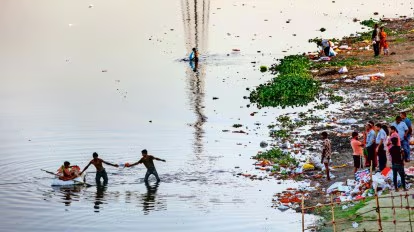Legal Protection of Domestic Workers
Syllabus: GS1/ Society, GS2/ Governance
In News
- In a landmark move, the Supreme Court of India has directed the Union government to examine the need for a separate law for domestic workers.
- The Court has ordered the formation of an inter-ministerial committee to assess and recommend a legal framework for their benefit, protection, and regulation of rights.
Current Situation of Domestic Workers
- About:
- Despite their crucial role in millions of households, domestic workers lack legal protection under many labour laws, including the Minimum Wages Act and the Equal Remuneration Act.
- While some states have introduced regulations, there is no national-level law ensuring their rights.
- Vulnerability and Exploitation:
- Domestic work is a feminized occupation, with a large proportion of workers being women from marginalized communities.
- Workers face low wages, job insecurity, and increased workloads without additional pay.
- Social security measures are almost non-existent, leaving workers vulnerable to financial crises.
- Domestic work is socially undervalued and perceived as an inherent skill all women should possess, contributing to its invisibility and lack of recognition.
Challenges and Judicial Interventions
- ILO Convention 189: India has not ratified this global standard on domestic workers’ rights, which mandates fair wages, social security, and protection against abuse.
- Judicial Orders on Placement Agencies: The Supreme Court has previously directed the registration of placement agencies, but enforcement remains weak, leaving workers unprotected.
- Complex Employment Structures: Domestic work exists in multiple forms—part-time, full-time, making it difficult to implement standardized protections.
Need for Inclusive Legislation
A separate law for domestic workers is essential to address their unique challenges:
- Proof of Employment: Enforcing legal protections requires formal documentation of employment, which is currently difficult for workers to obtain.
- Employer Resistance: Many employers do not recognize themselves as “employers” or consider their homes as formal workplaces.
- Power Imbalance: The asymmetric employer-employee relationship—where the employer’s private space is the worker’s workplace—limits oversight and regulation.
Opportunities and Challenges in Implementation
- Ensuring Core Entitlements: A well-structured law can establish minimum wages, regulate working hours, and provide social security, significantly improving conditions for domestic workers.
- Redefining Power Hierarchies: Legal protections will challenge the existing power dynamics and recognize the value of housework and care work.
- Regional Considerations: States like Kerala and Delhi have implemented measures for domestic workers, which can serve as models for national legislation.
- Challenges in Enforcement: Even with a new law, effective implementation remains a key challenge, requiring strong monitoring mechanisms and employer accountability.
Conclusion
- The Supreme Court’s directive presents a crucial opportunity to advocate for a national law protecting domestic workers. While legislation alone may not immediately transform working conditions, it is a necessary first step toward recognizing their rights, ensuring fair wages, and providing social security. The real impact will depend on the recommendations of the committee and the Union government’s commitment to enforcing meaningful reforms.
Jal Jeevan Mission (JJM) Extended Till 2028
Syllabus: GS2/ Welfare Schemes
In News
- Union Finance Minister Nirmala Sitharaman announced an extension of the Jal Jeevan Mission (JJM) till 2028, with an outlay of Rs 67,000 crore in the Union Budget 2025-26.
- However, the scheme saw a massive cut in allocation at the revised estimate (RE) stage during the current fiscal year 2024-25.
About
- The Jal Jeevan Mission (JJM), launched in 2019, aimed to provide Functional Household Tap Connections (FHTC), ensuring 55 litres per capita per day of safe drinking water to all rural households by 2024. However, due to implementation challenges, the deadline has now been extended to 2028.
- The focus now shifts towards quality infrastructure, sustainable operation, and community-led management under the principle of “Jan Bhagidari” (people’s participation).
Key Features of JJM
- Objectives & Implementation Strategy:
- Universal Piped Water Access: Ensuring every rural household receives tap water by 2028.
- Community Involvement: Village Water & Sanitation Committees (VWSCs) or Pani Samitis play a key role, with 50% mandatory participation from women.
- State Participation: States/UTs sign agreements to ensure sustainability and service quality.
- Administrative Framework:
- Nodal Ministry: Department of Drinking Water and Sanitation, Ministry of Jal Shakti.
- Background: JJM subsumed the National Rural Drinking Water Programme (NRDWP).
- Funding Pattern:
- 90:10 for Himalayan and North-Eastern States.
- 100% Central Funding for Union Territories.
- 50:50 for other States.
Current Progress & Budgetary Allocations
- Achievements Since 2019:
- 80% of rural households now have piped water access, up from 15% in 2019.
- Over 12 crore families have gained access to drinking water.
- States with 100% Coverage: Arunachal Pradesh, Goa, Haryana, Himachal Pradesh, Gujarat, Punjab, Telangana, and Mizoram.
- UTs with 100% Coverage: Andaman & Nicobar Islands, Dadra & Nagar Haveli & Daman & Diu, and Puducherry.
Challenges in Implementation
- Infrastructure & Connectivity Issues:
- Initial “Low-Hanging Fruit” Approach: Coverage was quickly expanded in regions with existing infrastructure, but expanding to remote villages has proven difficult.
- Reservoir-to-Village Pipelines: Many villages require water transportation from distant reservoirs, increasing costs and logistical complexity.
- Cost Overruns Due to External Factors:
- COVID-19 Impact: Disruptions in supply chains and labor availability.
- Russia-Ukraine War: Equipment and material costs surged, straining budgets.
- Implementation Bottlenecks:
- Underutilization of Funds: Despite budget allocations, ₹50,000 crore remained unspent in 2024-25, highlighting execution inefficiencies.
Road Ahead
- Strengthening Last-Mile Connectivity: Prioritizing infrastructure expansion in remote areas.
- Upgrading reservoir pumping systems and ensuring adequate groundwater sources.
- Improving Budget Utilization: Enhancing state-level execution capacity to ensure timely use of allocated funds.
- Flexible funding mechanisms to accommodate price fluctuations.
- Ensuring Transparency & Accountability: Implementing independent verification mechanisms to validate actual water supply in rural households.
- Leveraging technology (IoT-based monitoring, GIS mapping) for real-time tracking.
- State & Centre Coordination: Ensuring states fulfill their funding responsibilities to avoid delays.
- Stronger agreements between the Centre and states for smooth implementation.
- Community Engagement & Women’s Participation: Expanding “Jan Bhagidari” (people’s participation) to ensure local ownership of water management.
- Increasing women’s leadership roles in Pani Samitis.
Rules For Registering Live-in Relationships Under UCC
Syllabus: GS1/Society; GS2/Government Policies & Interventions
Context
- The newly implemented Uniform Civil Code (UCC) in Uttarakhand has introduced a set of detailed rules for registering live-in relationships, aiming to regulate such relationships and ensure that they are recognized legally.
- However, they have also sparked significant debate and raised concerns about privacy and state surveillance.
About Live-in Relationships in India
- The concept of live-in relationships, where couples cohabit without formal marriage, has gained legal and social recognition in India over the past two decades.
- Historical Context: Historically, Indian society has been rooted in traditional values, where marriage was the only recognized form of a committed relationship.
- Live-in relationships were often stigmatized and faced societal disapproval.
- However, with the influence of globalization and exposure to Western culture, the acceptance of live-in relationships has grown.
Legal Recognition of Live-in Relationships in India
- Indian courts have acknowledged live-in relationships through various judgments, primarily invoking the Right to Life and Personal Liberty (Article 21) of the Constitution.
- Various Judgements:
- S. Khushboo v. Kanniammal (2010): It ruled that live-in relationships fall under the right to personal liberty.
- Indra Sarma v. V.K.V. Sarma (2013): It categorized live-in relationships into various types, recognizing those that resemble marriage under Protection of Women from Domestic Violence Act, 2005 (PWDVA).
- The Chief Justice of India has emphasized that the freedom to choose a partner and form intimate relationships falls under the ambit of free speech and expression, as enshrined in Article 19(c) of the Constitution.
- Protection Against Domestic Violence Act, 2005 (PWDVA): It includes within its ambit ‘relationships in the nature of marriage’, thereby extending protection to women in live-in relationships who face domestic violence.
- In D. Velusamy v. D. Patchaiammal (2010), the Court held that only relationships in the nature of marriage would be eligible for legal protection under domestic violence laws.
- Inheritance and Maintenance Rights: In cases where the couple has children, the Supreme Court has held that children born out of live-in relationships are entitled to inheritance rights similar to those born to legally married parents.
Rules For Registering Live-in Relationships Under UCC
- The Uttarakhand UCC mandates the registration of live-in relationships. It applies to both residents of Uttarakhand and individuals residing elsewhere in India.
- Registration Requirements: Under the UCC, couples entering into a live-in relationship must register their relationship both at the commencement and termination stages.
- Supporting documents include Aadhaar-linked OTPs, a registration fee, and a certificate from a religious leader affirming the couple’s eligibility for marriage if they wish to formalize their relationship.
- Prohibited Relationships: The UCC Act specifies 74 prohibited relationships, with 37 each for men and women.
- Couples falling within these degrees of prohibited relationships must obtain approval from religious leaders or community heads.
- The registrar has the authority to reject registrations if they conclude that the relationship is against public morality or customs.
Key Concerns and Impacts
- Privacy Concern: It is argued that it constitutes a gross violation of the right to privacy enshrined in Article 21 of the Constitution (Justice K.S. Puttaswamy v. Union of India), as increased state surveillance over private lives.
- New rules have raised concerns about the potential barriers they create for interfaith and inter-caste relationships.
- Rights of Women and Children: Currently, women in live-in relationships can claim maintenance under Section 125 of the Criminal Procedure Code (CrPC) and PWDVA, 2005, but these rights are not absolute.
- Protection Against Misuse: Individuals may enter into such relationships without long-term commitment but later claim legal rights, leading to legal disputes.
- Social and Cultural Challenges: It challenges traditional notions of family and marriage, and raises questions about the moral and ethical implications of live-in relationships, particularly in conservative communities.
Conclusion and Way Forward
- While the UCC in Uttarakhand aims to provide legal recognition and protection for live-in relationships, it also raises important concerns about privacy and state intervention.
- The balance between regulating relationships and respecting individual autonomy will be crucial in ensuring that the new rules are implemented in a manner that promotes social harmony and protects the rights of individuals.
- If UCC replaces personal laws, there is a need to focus on:
- ensuring equal rights for women in live-in relationships.
- providing inheritance and maintenance rights similar to those in marriage.
- clarifying the legal status of children born out of live-in relationships, especially regarding legitimacy and inheritance rights.
Budget 2025-26 :Key Highlights
Syllabus :GS3/Economy
In Context
- The Union Budget 2025-26 was framed around the theme “Sabka Vikas,” emphasizing balanced growth across all regions of India.
- The term ‘budget’ has nowhere been mentioned in the Constitution. It is mentioned as ‘Annual financial statement’ in Article 112.
About
- The Finance Minister quoted the renowned Telugu poet Shri Gurajada Appa Rao’s saying, “A country is not just its soil; a country is its people,” to highlight the importance of people-centric development.
- Principles of Viksit Bharat:
- Eradicate poverty (Zero-poverty)
- Provide high-quality, universal school education
- Ensure access to affordable, comprehensive healthcare
- Achieve full employment with a skilled workforce
- Involve 70% women in economic activities
- Strengthen agriculture to make India the “food basket of the world
| Budget Estimates 2025-26 – The total receipts other than borrowings and the total expenditure are estimated at ₹ 34.96 lakh crore and ₹ 50.65 lakh crore respectively. – The net tax receipts are estimated at ₹ 28.37 lakh crore. – The fiscal deficit is estimated to be 4.4 per cent of GDP. – The gross market borrowings are estimated at ₹ 14.82 lakh crore. – Capex Expenditure of ₹11.21 lakh crore (3.1% of GDP) earmarked in FY2025-26. |
Key Engines of Growth
- Agriculture (1st Engine): Launch of Prime Minister Dhan-Dhaanya Krishi Yojana to cover 100 districts.
- Mission for Aatmanirbharta in Pulses for Tur, Urad, and Masoor pulses.
- Loan limit for Kisan Credit Cards raised from ₹3 lakh to ₹5 lakh.
- Comprehensive program for vegetables, fruits, high-yield seeds, and cotton productivity.
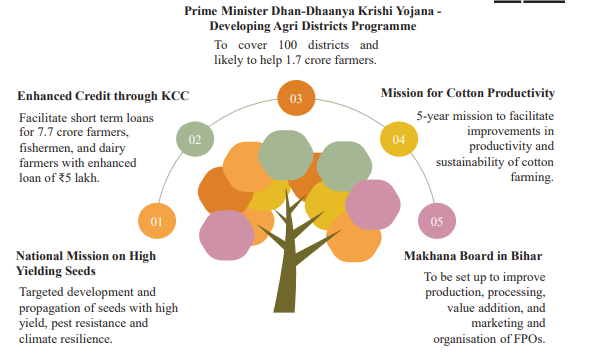
- MSMEs (2nd Engine): MSME investment & turnover limits enhanced to 2.5 and 2 times.
- Credit cards for micro enterprises and a loan scheme for 5 lakh women and marginalized entrepreneurs.
- Development of a toy manufacturing hub and National Manufacturing Mission.

- Investment (3rd Engine): 50,000 Atal Tinkering Labs to be set up in schools.
- Broadband for all secondary schools & PHCs under BharatNet project.
- Establishment of National Centres of Excellence for skilling.
- ₹1.5 lakh crore for 50-year interest-free loans to states for capital expenditure.
- Urban Challenge Fund of ₹1 lakh crore to support urban development.
- ₹20,000 crore for private sector-driven R&D and innovation.
- National Geospatial Mission for urban planning and Gyan Bharatam Mission for manuscript conservation.
- Nuclear Energy Expansion: Rs.20,000 crore for Small Modular Reactors (SMRs).
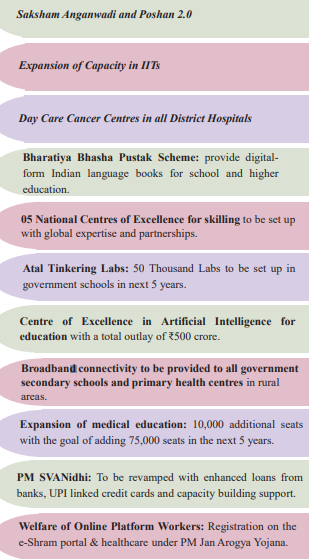
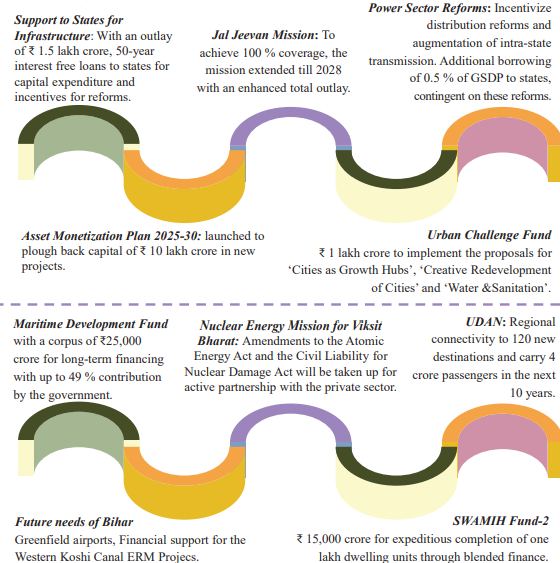
- Exports (4th Engine): Launch of Export Promotion Mission and BharatTradeNet for trade documentation.
- Support for domestic manufacturing and integration with global supply chains.
- Infrastructure support for air cargo and fisheries exports.
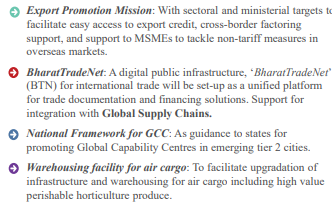
Reforms
- Financial Sector : Increase in FDI limit in insurance from 74% to 100%.
- Establishment of a High-Level Committee for Regulatory Reforms.
- Introduction of the Investment Friendliness Index of States.
- Decriminalization of 100+ provisions under the Jan Vishwas Bill 2.0.
- Financial Stability and Development Council (FSDC) to review regulations.
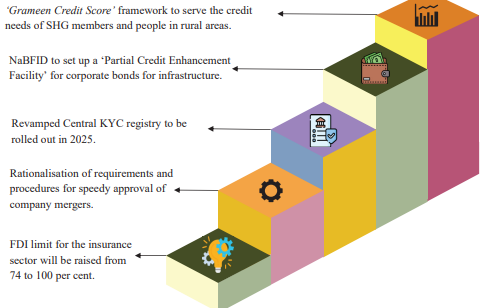
- Taxation & Fiscal Policy: Fiscal deficit target of 4.4% of GDP for FY 2025-26.
- Increased receipts and expenditure estimates for 2025-26.
- Commitment to fiscal consolidation with a clear roadmap.
Tax Proposals :
- Personal Income Tax Reform: no tax for income up to ₹12 lakh per annum.
- Standard deduction of ₹75,000 for income up to ₹12.75 lakh.
- Estimated ₹1 lakh crore revenue loss due to tax reforms.
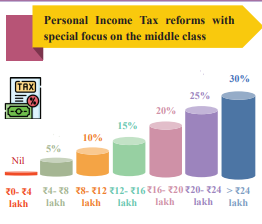
- TDS/TCS Rationalization: TDS limit on interest for senior citizens increased from ₹50,000 to ₹1 lakh.
- TDS threshold on rent raised to ₹6 lakh from ₹2.4 lakh.
- Extension of updated returns filing to 4 years for any assessment year.
- Compliance Simplification: Increase in registration period for small charitable trusts from 5 to 10 years.
- Senior citizens benefit from tax exemption on National Savings Scheme withdrawals.
- Promotion of Employment & Investment: Presumptive taxation regime for non-residents providing services to electronics manufacturing companies.
- Extension of the Sovereign Wealth Funds and Pension Funds investment deadline to 2030.
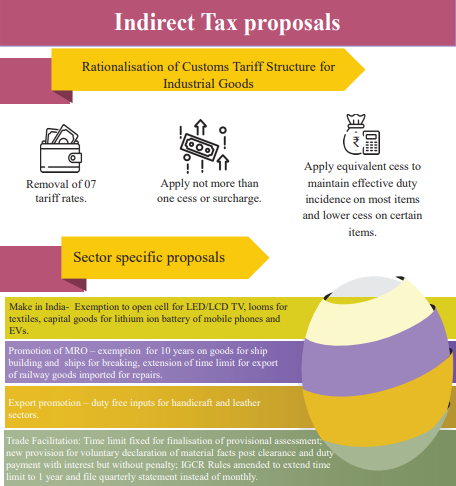
- Customs Tariff Reforms: Removal of seven tariffs, simplification of cess, and reduction of Basic Customs Duty (BCD) on critical minerals and textiles.
- Reduction in BCD on lithium-ion battery manufacturing capital goods and shipbuilding materials.
- Duty adjustments to encourage domestic manufacturing.
- Export Promotion: Reduction of BCD on fish products and leather to boost exports.
- Fully exempted BCD on lifesaving medicines for cancer, rare diseases, and chronic illnesses.
Aatmanirbharta in Pulses
Syllabus: GS3/Economy
Context
- The Finance Minister has announced the launch of a six-year ‘Mission for Aatmanirbharta (self-reliance) in Pulses’.
About
- Budget Allocation: Rs 1,000 crore.
- Aim: To boost the output and help achieve self-sufficiency in pulses, with special focus on tur/arhar (pigeonpea), urad (black gram) and masoor (red lentil).
- It will provide minimum support price (MSP)-based procurement and post-harvest warehousing solutions.
- India’s Target: India has set a target to end India’s dependence on imports to meet the country’s pulses demand by 2029.
- Recently the Union Home Minister declared a goal that India will stop importing pulses by 2028-29.
Import of Pulses
- In 2023-24, imports went up 84% higher year-on-year to 4.65 million tonnes, the most in six years.
- In value terms, the country’s spending on imports rose 93% to $3.75 billion.
- India largely imports from Canada, Australia, Myanmar, Mozambique, Tanzania, Sudan and Malawi.
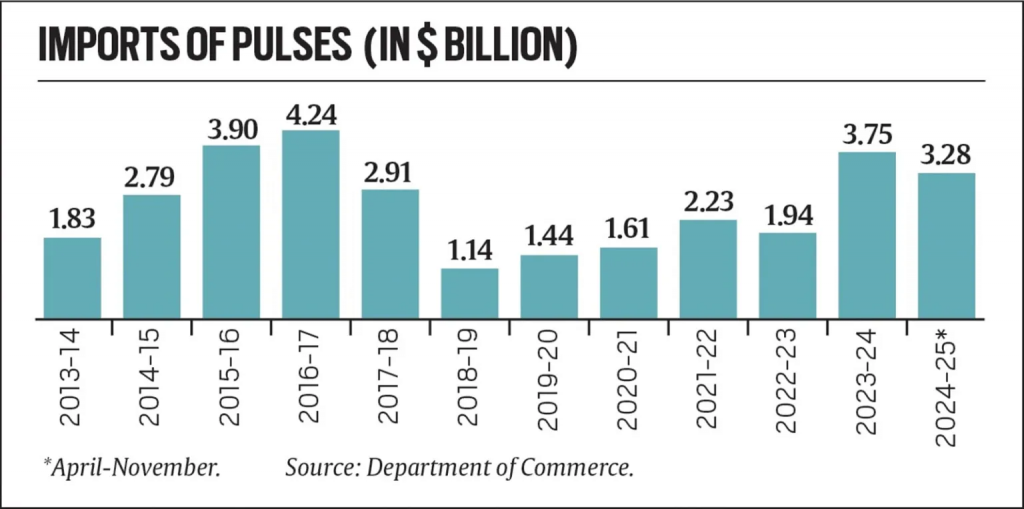
Production of Pulses in India
- India is the largest producer (25% of global production), consumer (27% of world consumption) and importer (14%) of pulses in the world.
- Pulses account for around 23% of the area under food grains and contribute around 9-10% of the total foodgrains production in the country.
- Rabi pulses contribute more than 60 percent of the total production.

- Gram is the most dominant pulse having a share of around 40% in the total production followed by Tur/Arhar at 15 to 20% and Urad/Black Matpe and Moong at around 8-10% each.
- Madhya Pradesh, Maharashtra and Rajasthan are the top three pulses producing states in the country.
- Domestic pulses production increased from 192.55 lt in 2013-14 to 273.02 lt in 2021-22 and 260.58 lt in 2022-23.
- This was mainly courtesy two crops: chana and moong (green gram).
Challenges
- Low Productivity: Pulses have traditionally been a neglected crop because of the instability of its yields.
- Residual Crop: Pulses in India are considered a residual crop and grown under rain-fed conditions in marginal/less fertile lands, with very little focus on pest and nutrient management.
- With the advent of the Green Revolution, which promoted rice and wheat using external inputs and modern varieties of seeds, pulses were pushed to the marginal lands. This resulted in decline in productivity and land degradation.
- Lack of Technological Advances: There has been no technology breakthrough in any of the pulses crops.
- Less Beneficial: Farmers perceive pulses as having a lower cost benefit ratio vis-à-vis other crops like wheat and rice.
- Penetration and adoption of high yielding varieties (HYV) seeds are also low.
- Post Harvest Losses: There are post-harvest losses during storage, due to excessive moisture and attack by stored grain pests especially the pulse beetle.
Measures Taken By the Government to Increase Production
- National Food Security Mission: The Department of Agriculture & Farmers Welfare is implementing the National Food Security Mission (NFSM)-Pulses with the objectives of increasing production through area expansion and productivity enhancement in all the districts.
- Research and Development: The Indian Council of Agricultural Research (ICAR) is undertaking basic and strategic research on these crops and applied research in collaboration with State Agricultural Universities for developing location-specific high yielding varieties.
- PM-AASHA: Government implements an umbrella scheme PM-AASHA comprising Price Support Scheme (PSS), Price Deficiency Payment Scheme (PDPS) and Private Procurement Stockist Scheme (PPSS) in order to ensure Minimum Support Price (MSP) to farmers for their produce of notified oilseeds, pulses and copra.
- Integrated scheme of Oilseeds, Pulses, Oil Palm and Maize (ISOPOM) was launched in 14 major pulses growing states.
- Rashtriya Krishi Vikas Yojna was launched under which states can undertake Pulses Development Programmes.
Way Ahead
- Model Pulses Villages: According to the agriculture ministry’s plan to achieve self-sufficiency, model pulses villages will be set up from the current kharif or summer-sown season.
- Use of Fallow Land: The ministry is also working with states to bring fallow land for cultivation of lentils.
- Hubs: It is set to create 150 hubs to distribute high-yielding seeds.
- Alongside, the farm department will collaborate with the department of agricultural research to promote climate-resilient varieties.
- The government has to ensure crop diversification and incentivize farmers sufficiently across varieties to stop imports.
OTHERS:
Gyan Bharatam Mission
Syllabus: GS1/ Art & Culture
In News
- The Gyan Bharatam Mission was announced in the Union Budget 2025-26.
About
- It is a landmark initiative focused on the survey, documentation, and conservation of India’s manuscript heritage.
- The mission aims to cover more than one crore manuscripts, ensuring their preservation and accessibility for future generations.
- With this initiative, the government is taking significant steps to reviving the National Manuscripts Mission (NMM) launched in 2003 but largely inactive, and promoting India’s rich literary and intellectual traditions at a global level.
- To accommodate this initiative, the budget for the National Manuscripts Mission (NMM) has been significantly increased from ₹3.5 crore to ₹60 crore.
Significance of the Mission
- Preserving India’s Intellectual and Cultural Heritage: Manuscripts hold knowledge on subjects such as philosophy, science, medicine, literature, mathematics, and astronomy. Their preservation helps safeguard India’s historical wisdom.
- Digital Access for Future Generations: Manuscripts often suffer from physical decay. Digitization ensures 24/7 access to these texts worldwide while preventing deterioration.
- Global Academic Impact: By making manuscripts available for study, India strengthens its position as a hub of ancient knowledge and scholarship.
Understanding Manuscripts
- A manuscript is a handwritten document on materials such as paper, birch bark, or palm leaves. To be classified as a manuscript, it must be at least 75 years old and hold scientific, historical, or aesthetic value.
- India has an estimated 10 million manuscripts in over 80 ancient scripts, including:
- Brahmi, Kushan, Gaudi, Lepcha, Maithili, Grantha, and Sharada.
- 75% of manuscripts are in Sanskrit, while 25% are in regional languages.
- India has an estimated 10 million manuscripts in over 80 ancient scripts, including:
Source: TH
Green Cardamom
Syllabus: GS3/Economy/Agriculture
Context
- Researchers have identified six species that are closely related to Elettaria cardamomum, better known as green cardamom.
About
- Of the six, four were previously placed in a separate genus, Alpinia, while the remaining two have been newly identified and described from Kerala’s Western Ghats regions.
- Following the reclassification, the genus Elettaria now has seven species, including Elettaria cardamomum. E. ensal, E. floribunda, E. involucrata and E. rufescens were earlier placed in the genus Alpinia.
- The remaining two are new species, Elettaria facifera and Elettaria tulipifera.
- Seed capsules of Elettaria cardamomum provide the commercial green cardamom.
- The genus name is based on this spice’s old Malayalam name, ‘elletari’ as used by Hendrik van Rheede in the 17th century.
About Cardamom
- Cardamom is one of the world’s most exotic spices – along with Saffron and Vanilla.
- It belongs to the same botanical family as ginger and turmeric (Zingiberaceae).
- It is also one of the world’s oldest spices – cultivated for more than 4000 years.
- Evergreen forests of Western Ghats of South India are considered as the centre origin of cardamom.
- Guatemala is the world’s largest producer of cardamom, India is the second largest producer.
- Top Producing States: Kerala (56.71%), Karnataka (35.91%) and Tamil Nadu (7.31%).
Source: TH
Samudrayaan Mission
Syllabus: GS3/Science and Technology
Context
- Samudrayaan Mission has been allocated Rs 600 crore in Union Budget 2025-26.
About
- Launched in 2021, it is India’s first manned ocean mission to explore the deep ocean.
- It is a project of the Ministry of Earth Sciences (MoES) under the Deep Ocean Mission.
- The technology is being developed by the National Institute of Ocean Technology (NIOT).
- NIOT is an autonomous institute under MoES, has developed a 6000m depth-rated Remotely Operated Vehicle (ROV) ‘Matsya 6000’.
- The mission aims to send three people to a depth of 6,000 meters in a submersible called the MATSYA 6000.
- The submersible will have an operational endurance of 12 hours, which is extendable up to 96 hours in the event of an emergency.
- Objectives of the Mission:
- To study deep-sea marine life.
- To explore the distribution of polymetallic nodules, which are rich in minerals such as copper, nickel, and cobalt.
- To study the impact of climate change on the ocean.
- To develop India’s capabilities in deep-sea exploration and research as well as develop underwater vehicles and underwater robotics.
- To develop offshore-based desalination techniques, renewable energy generation techniques, and provide clean drinking water and explore the avenues of desalination of water.
- So far, countries such as the U.S., Russia, China, France and Japan have carried out successful deep-ocean crewed missions.
Source: TOI
Trial of Very Short-Range Air Defence System (VSHORADS)
Syllabus: GS3/Defence
Context
- The Defence Research and Development Organisation (DRDO) successfully conducted three successive flight-trials of the Very Short-Range Air Defence (VSHORAD) system.
About
- It targets high-speed, low-altitude drone threats.
- The test confirmed the VSHORADS precision in neutralising aerial threats.
- The VSHORAD is a portable air defence system designed and developed indigenously by Research Center Imarat in collaboration with other DRDO laboratories.
- The missile system has the capability to meet the needs of all the three branches of the armed forces — the Army, Navy and the Air Force.
- It offers close air defence protection for mobile formations, especially in the growing threat of drones and loitering munitions.
